Goodbye google maps
- Transfer
Google decided to make Google Maps a new billion-dollar business, raising prices by 14 times and reducing the free use limit by almost 30 times, all with a minimum notice period. Fortunately, this immediately stimulated competition. Apple Maps, MapBox, TomTom - what to choose?
Our startup GdziePoLek.pl allows patients to find the right drugs in regular pharmacies. And even by the name ( “where to find medicines” ) it is clear how important is the display on the map . The service is easy to explain with one picture, against which Google Maps have always been:
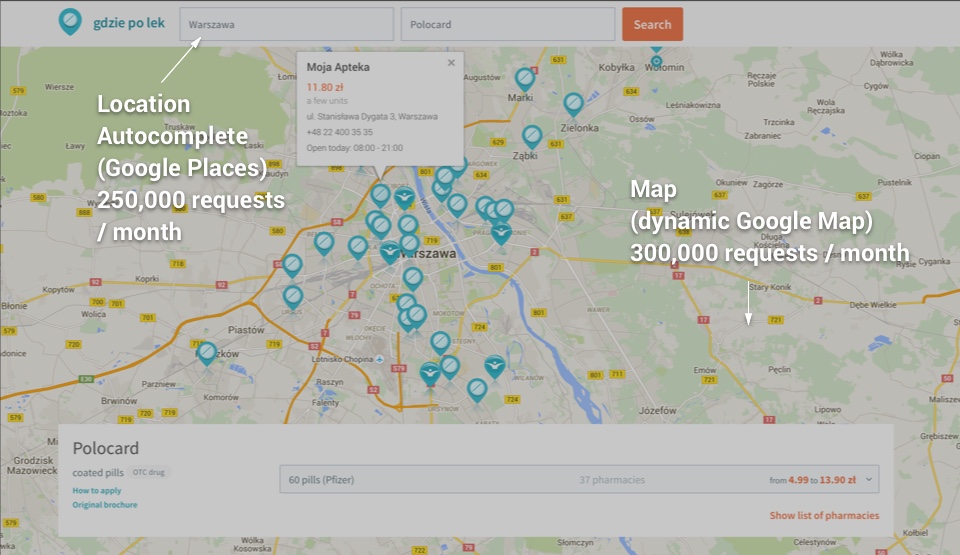
A typical page of our service shows the availability of medication in pharmacies
Of course, we always knew that with an increase in business we would have to pay for Google Maps.
Until now, the free use limit of about 750 thousand map downloads was in good agreement with the scale of the business, when you can expect a profit. The price for commercial use ($ 0.5 for 1000 map downloads) was not high enough to consider alternatives.
But in June, we received a letter, where we were called a client who “intensively uses” Google Maps:
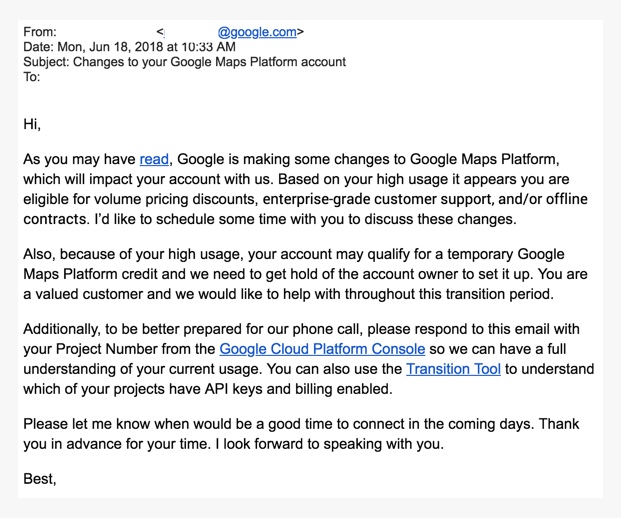
Email from Google
After a teleconference with a customer service representative (who did not offer any discounts despite the letter), we realized that the price increase was huge:
It is important to note that prices are the same from the USA to Africa, although the possibilities of monetization are significantly different, as we know, compared to Poland with the German market.
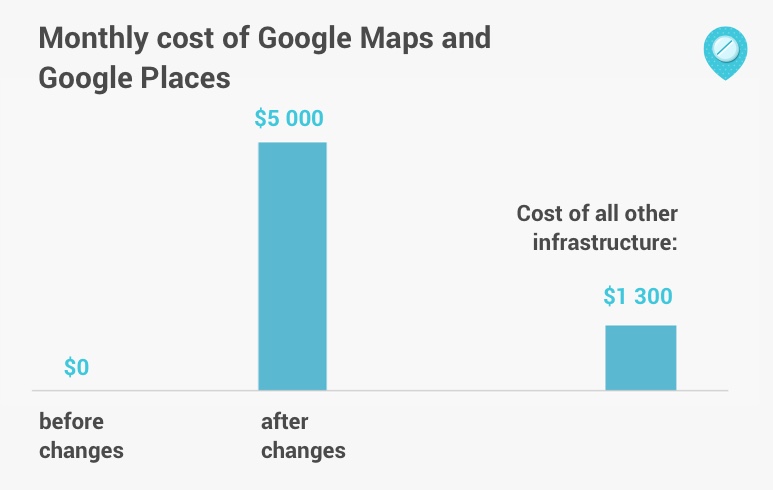
Comparing the monthly account for Google Maps before and after the price increase
If you keep normal use of maps and location services, the cost of Google Maps becomes many times higher than the previous cost of the entire infrastructure.
Google Maps is objectively the best product on the market, in many ways a lot stronger than its competitors. Justin O'Beirn made an excellent analysis of how advanced Google maps are compared to the rest.
The good news for us is that even maps that are deeply integrated into our service, in reality, do not carry any important workload, besides displaying the location of pharmacies. Therefore, we do not need advanced features such as satellite imagery, routing and other routes that are difficult to replace with other APIs.
What is important is the visual quality of the maps and the level of detail they provide in the territory where we work, and this is mainly Poland and, I hope, soon Germany. Below is a comparison of how the same location in the center of Warsaw looks in different map services:
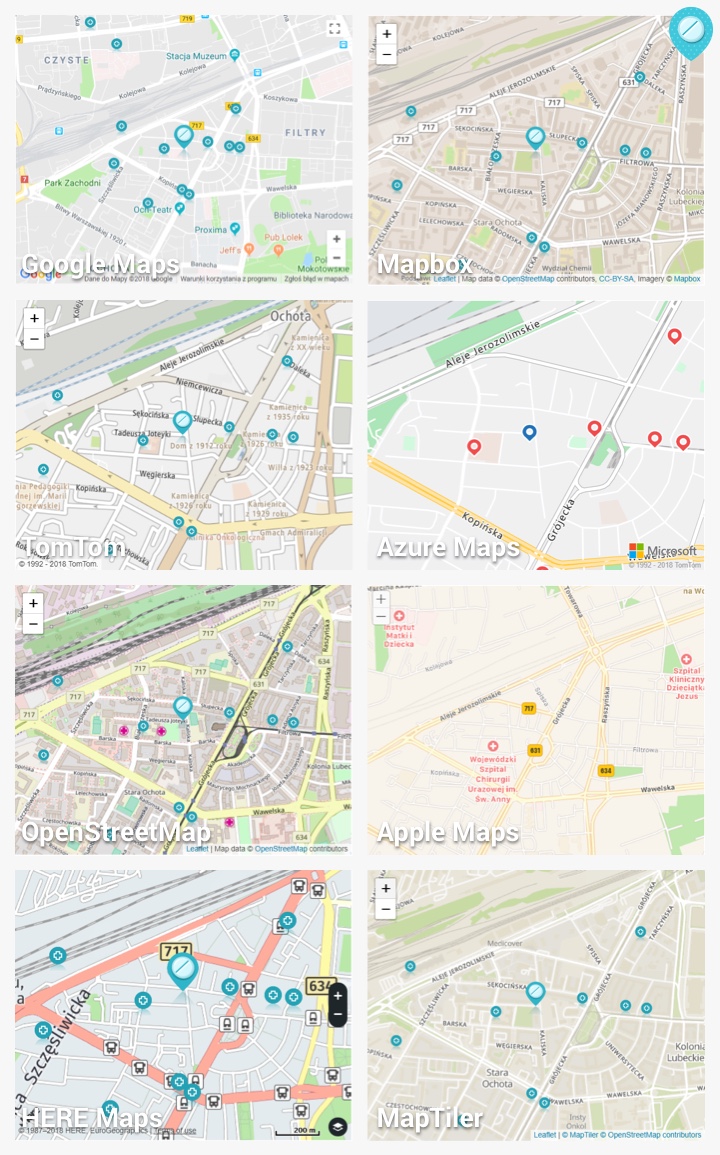
The same pharmacy in Warsaw on different maps. Whenever possible, the appearance of the GdziePoLek markers is taken into account.
At first glance, almost every service provides good quality when it comes to the center of Warsaw. The exception is Azure Maps, which was launched a couple of months ago. To be fair, it should be noted: Microsoft declares that it specifically left a void on the cards for the convenience of corporate partners who add a lot of information to their layers.
Maybe the center of Warsaw is not the best test for assessing the quality of maps throughout Poland? We also tested small cities, here is a similar comparison for Konstancin:
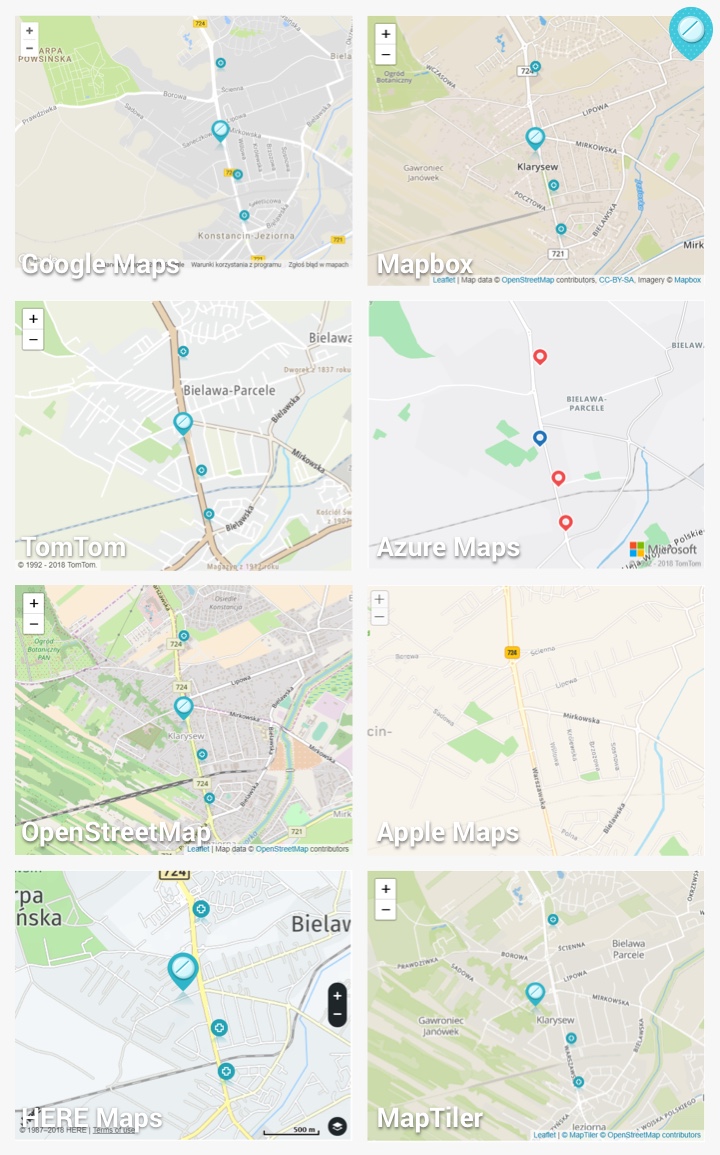
Pharmacy in the vicinity of Konstancin-Jeziorna
Contrary to fears, we are not hostages of Google Maps, and many alternatives look surprisingly decent.
Added by:It is often possible to create custom card styles. We have not studied it, because we do not use custom maps on our site. But this is clearly important for Mapbox, where the mention of various editors is a bit confusing when studying prices (below) and MapTiler (the setup guide here ).
Services have different pricing models, making it difficult to directly compare prices. Below is an overview of the options for paid use (excluding the free use rate):
The Google model seems to be the most transparent (leaving aside the price), because each page with a map will cost the same.
In the case of payment for tiles, as in MapTiler, everything becomes more complicated. The number of tiles on the map depends on its size, and in the case of responsive sites it depends on the display resolution. In addition, the user can move the map or zoom in, loading additional tiles.
Mapbox prices seem the least transparent. Not only is it difficult to understand how many tiles are included in the price of a single “map display”, but the term “map display” itself is misleading (other companies use, for example, the word “transaction” to understand that the board does not necessarily cover the full cost of one display cards).
From the analysis of pricing policy is difficult to understand what will be the daily value of cards in real terms. For example, on the GdziePoLek website there are also small cards with one pharmacy, and huge full-screen maps with search results - only for desktops.
What cards to learn more?
Some options can be immediately rejected for various reasons. OpenStreetMap cannot be used directly on commercial sites. Although we do not object to the Apple logo on our website, but Apple Maps is still in beta testing and requires an Apple developer account for full testing.
It would be great to use Azure Maps along with our Azure cloud services, but the proprietary Javascript API leaves much to be desired, even in the simplest cases (for example, when adding custom markers). HERE
Cardsvisually badly correspond to our site, they have a non-standard API. We also prefer to pay for actually used services, rather than buying packages. But one of the friendly large sites migrated to HERE, so let's see how these cards will work for them.
We decided that the most attractive option is to use an open JS-library like Leaflet with the possibility of an inconspicuous change of providers supplying cartographic tiles.
This can be done using Mapbox or MapTiler , and possibly TomTom, although the latter has a slightly modified Leaflet client and requires prepayment instead of payment as it is used, which we prefer.
We have expanded our application to be able to change the provider of cards with one click of the mouse in the admin console. Then we estimated the volume of daily consumed resources for each provider, that is, Google Maps, Mapbox and Maptiler.
Here is how it looks in practice.
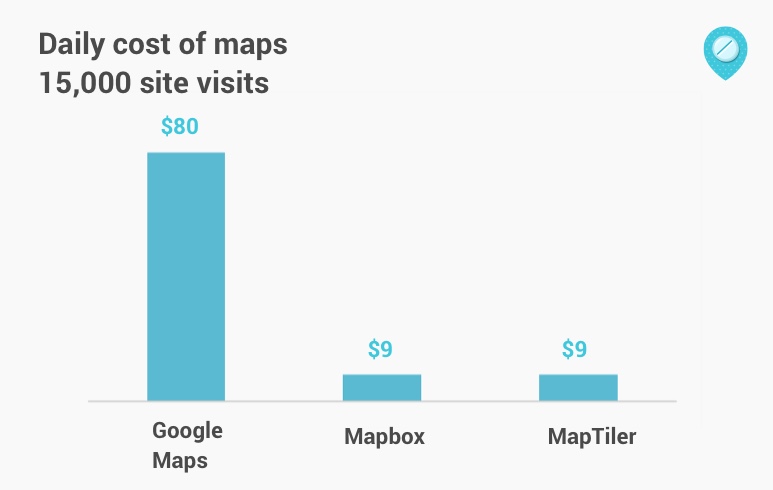
Comparison of the actual cost of cards for one day (15,000 visits to the site, of which not all can include cards). The comparison is specific to GdziePoLek.pl and our use of maps throughout the site, as well as the screen sizes of users with the generation of maps of different sizes
. Google Maps is the most favorable model for customers who have intensive interaction with maps like us, but a radical price increase anyway makes this service the most expensive solution for us.
As it turned out, the cost of using Mapbox and MapTiler in our case is comparable, despite the slightly different billing model.
From a business point of view, Mapbox has much more resources - 400 employees on LinkedIn compared with seven from MapTiler - thanks to Softbank's investment of $ 164 million. With this capital, the company intends to develop in many areas (unmanned vehicles, VR ...). From the point of view of the mapping service user, this is a bit of a concern. Therefore, we will continue to use both services at the same time.
If it were not for a radical increase in prices, we would not even consider an alternative to Google Maps on our own initiative as an obvious example of the situation “it works - do not touch”.
The sudden change in Google policy aimed at start-ups (since small sites will not experience changes due to minimal traffic) was an unpleasant surprise for us and, of course, influenced the company's perception as a service provider. Therefore, in the future, we will stay away from Google Cloud and avoid deep integration with any Google services that a company may throw such a focus on. Obviously, Google may see a new “billion-dollar business,” for example, in Google Analytics .
On the other hand, we were impressed by the quality of open source and the management of Leaflet. Some advanced features that need to be added manually to Google Maps were immediately available in the Leaflet.
For those who start a startup with abundant use of maps, we recommend using Leaflet and one of the independent card providers, rather than becoming dependent on Google.
Our startup GdziePoLek.pl allows patients to find the right drugs in regular pharmacies. And even by the name ( “where to find medicines” ) it is clear how important is the display on the map . The service is easy to explain with one picture, against which Google Maps have always been:

A typical page of our service shows the availability of medication in pharmacies
Of course, we always knew that with an increase in business we would have to pay for Google Maps.
Until now, the free use limit of about 750 thousand map downloads was in good agreement with the scale of the business, when you can expect a profit. The price for commercial use ($ 0.5 for 1000 map downloads) was not high enough to consider alternatives.
But in June, we received a letter, where we were called a client who “intensively uses” Google Maps:

Email from Google
After a teleconference with a customer service representative (who did not offer any discounts despite the letter), we realized that the price increase was huge:
- The current limit of free use of 750 thousand requests a month is reduced to 28 thousand (almost 30 times less)
- The current tariff of $ 0.5 for commercial use increases to $ 7 (14 times more), $ 5.60 with a discount for a large number of views.
It is important to note that prices are the same from the USA to Africa, although the possibilities of monetization are significantly different, as we know, compared to Poland with the German market.

Comparing the monthly account for Google Maps before and after the price increase
If you keep normal use of maps and location services, the cost of Google Maps becomes many times higher than the previous cost of the entire infrastructure.
Comparison of the appearance and detail of maps
Google Maps is objectively the best product on the market, in many ways a lot stronger than its competitors. Justin O'Beirn made an excellent analysis of how advanced Google maps are compared to the rest.
The good news for us is that even maps that are deeply integrated into our service, in reality, do not carry any important workload, besides displaying the location of pharmacies. Therefore, we do not need advanced features such as satellite imagery, routing and other routes that are difficult to replace with other APIs.
What is important is the visual quality of the maps and the level of detail they provide in the territory where we work, and this is mainly Poland and, I hope, soon Germany. Below is a comparison of how the same location in the center of Warsaw looks in different map services:

The same pharmacy in Warsaw on different maps. Whenever possible, the appearance of the GdziePoLek markers is taken into account.
At first glance, almost every service provides good quality when it comes to the center of Warsaw. The exception is Azure Maps, which was launched a couple of months ago. To be fair, it should be noted: Microsoft declares that it specifically left a void on the cards for the convenience of corporate partners who add a lot of information to their layers.
Maybe the center of Warsaw is not the best test for assessing the quality of maps throughout Poland? We also tested small cities, here is a similar comparison for Konstancin:

Pharmacy in the vicinity of Konstancin-Jeziorna
Contrary to fears, we are not hostages of Google Maps, and many alternatives look surprisingly decent.
Added by:It is often possible to create custom card styles. We have not studied it, because we do not use custom maps on our site. But this is clearly important for Mapbox, where the mention of various editors is a bit confusing when studying prices (below) and MapTiler (the setup guide here ).
Price comparison
Services have different pricing models, making it difficult to directly compare prices. Below is an overview of the options for paid use (excluding the free use rate):
- Google Maps - $ 7 for every 1000 map downloads, regardless of the size of the map or user zooming / panning ($ 5.60 with a large volume discount)
- Mapbox - $ 0.50 for each “map display”, which, despite the name, is not a map display, but requests 4 or 15 tiles (depending on the type of map), rounded up
- Azure Maps - $ 0.50 per 1000 "transactions", where the transaction is equal to 15 map tiles
- TomTom - $ 0.50 for 1000 “transactions” ($ 0.40 with maximum discounts), where the transaction is 15 card tiles
- HERE - package pricing, standard package costs $ 0.50 per 1000 "transactions" (15 tiles)
- MapTiler - $ 0.05 for each tile
- Apple Maps - is still in beta and offers a generous free discount on usage, without commercial prices
The Google model seems to be the most transparent (leaving aside the price), because each page with a map will cost the same.
In the case of payment for tiles, as in MapTiler, everything becomes more complicated. The number of tiles on the map depends on its size, and in the case of responsive sites it depends on the display resolution. In addition, the user can move the map or zoom in, loading additional tiles.
Mapbox prices seem the least transparent. Not only is it difficult to understand how many tiles are included in the price of a single “map display”, but the term “map display” itself is misleading (other companies use, for example, the word “transaction” to understand that the board does not necessarily cover the full cost of one display cards).
From the analysis of pricing policy is difficult to understand what will be the daily value of cards in real terms. For example, on the GdziePoLek website there are also small cards with one pharmacy, and huge full-screen maps with search results - only for desktops.
A short list of alternatives to Google Maps
What cards to learn more?
Some options can be immediately rejected for various reasons. OpenStreetMap cannot be used directly on commercial sites. Although we do not object to the Apple logo on our website, but Apple Maps is still in beta testing and requires an Apple developer account for full testing.
It would be great to use Azure Maps along with our Azure cloud services, but the proprietary Javascript API leaves much to be desired, even in the simplest cases (for example, when adding custom markers). HERE
Cardsvisually badly correspond to our site, they have a non-standard API. We also prefer to pay for actually used services, rather than buying packages. But one of the friendly large sites migrated to HERE, so let's see how these cards will work for them.
We decided that the most attractive option is to use an open JS-library like Leaflet with the possibility of an inconspicuous change of providers supplying cartographic tiles.
This can be done using Mapbox or MapTiler , and possibly TomTom, although the latter has a slightly modified Leaflet client and requires prepayment instead of payment as it is used, which we prefer.
Comparison of the actual daily cost for our site
We have expanded our application to be able to change the provider of cards with one click of the mouse in the admin console. Then we estimated the volume of daily consumed resources for each provider, that is, Google Maps, Mapbox and Maptiler.
Here is how it looks in practice.

Comparison of the actual cost of cards for one day (15,000 visits to the site, of which not all can include cards). The comparison is specific to GdziePoLek.pl and our use of maps throughout the site, as well as the screen sizes of users with the generation of maps of different sizes
. Google Maps is the most favorable model for customers who have intensive interaction with maps like us, but a radical price increase anyway makes this service the most expensive solution for us.
As it turned out, the cost of using Mapbox and MapTiler in our case is comparable, despite the slightly different billing model.
From a business point of view, Mapbox has much more resources - 400 employees on LinkedIn compared with seven from MapTiler - thanks to Softbank's investment of $ 164 million. With this capital, the company intends to develop in many areas (unmanned vehicles, VR ...). From the point of view of the mapping service user, this is a bit of a concern. Therefore, we will continue to use both services at the same time.
Lessons learned
If it were not for a radical increase in prices, we would not even consider an alternative to Google Maps on our own initiative as an obvious example of the situation “it works - do not touch”.
The sudden change in Google policy aimed at start-ups (since small sites will not experience changes due to minimal traffic) was an unpleasant surprise for us and, of course, influenced the company's perception as a service provider. Therefore, in the future, we will stay away from Google Cloud and avoid deep integration with any Google services that a company may throw such a focus on. Obviously, Google may see a new “billion-dollar business,” for example, in Google Analytics .
On the other hand, we were impressed by the quality of open source and the management of Leaflet. Some advanced features that need to be added manually to Google Maps were immediately available in the Leaflet.
For those who start a startup with abundant use of maps, we recommend using Leaflet and one of the independent card providers, rather than becoming dependent on Google.
